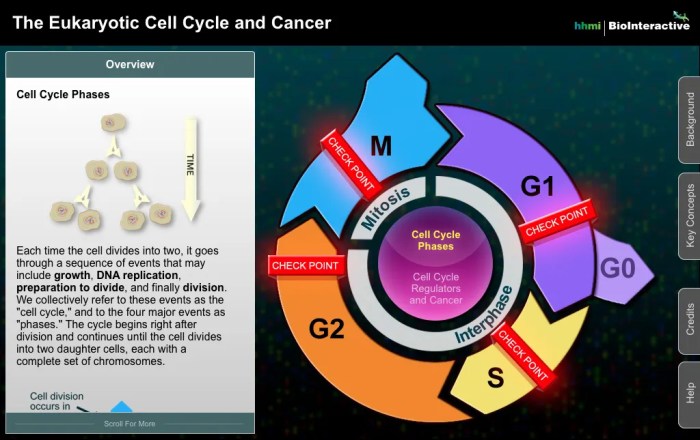The eukaryotic cell cycle and cancer in depth answers unveil the intricate dance of cellular division and its profound implications in cancer development. This comprehensive analysis delves into the stages of the cell cycle, their key events, and the checkpoints that orchestrate its progression.
By exploring the disruptions that can lead to cancer, we gain insights into the specific cell cycle checkpoints compromised in various cancer types.
Moreover, this in-depth examination sheds light on the experimental techniques employed to study the eukaryotic cell cycle, highlighting their advantages and limitations. We uncover the clinical significance of understanding the cell cycle, revealing its potential in developing cancer therapies. The challenges and opportunities in targeting the cell cycle for cancer treatment are also discussed, showcasing current and emerging therapies that exploit this knowledge.
1. Overview of the Eukaryotic Cell Cycle

The eukaryotic cell cycle is a complex and highly regulated process that ensures the accurate duplication and distribution of genetic material during cell division. It consists of four distinct phases: G1 (gap 1), S (synthesis), G2 (gap 2), and M (mitosis).
During G1, the cell grows and prepares for DNA replication. In S phase, the DNA is replicated, resulting in two identical copies of each chromosome. G2 is a period of further growth and preparation for mitosis. Finally, in mitosis, the replicated chromosomes are separated and distributed to two daughter cells.
Progression through the cell cycle is tightly controlled by a series of checkpoints that ensure that each phase is completed successfully before the cell proceeds to the next. The most important checkpoints are the G1/S checkpoint, which prevents cells from entering S phase with damaged DNA, and the G2/M checkpoint, which prevents cells from entering mitosis with incompletely replicated DNA or damaged chromosomes.
Cell cycle regulation is essential for maintaining genomic integrity and preventing cancer. Dysregulation of the cell cycle can lead to the accumulation of genetic mutations and uncontrolled cell proliferation, which are hallmarks of cancer.
2. The Eukaryotic Cell Cycle and Cancer: The Eukaryotic Cell Cycle And Cancer In Depth Answers
Disruptions in the cell cycle can lead to cancer through a variety of mechanisms. One common mechanism is the loss of checkpoint function. When checkpoints are not functioning properly, cells can enter S phase with damaged DNA or enter mitosis with incompletely replicated DNA or damaged chromosomes.
This can lead to the accumulation of genetic mutations and the development of cancer.
Another common mechanism of cell cycle dysregulation in cancer is the overexpression of cyclin-dependent kinases (CDKs). CDKs are enzymes that drive the cell cycle forward by phosphorylating specific proteins. When CDKs are overexpressed, they can push the cell cycle forward too quickly, leading to errors in DNA replication and chromosome segregation.
This can also lead to the accumulation of genetic mutations and the development of cancer.
Specific cell cycle checkpoints that are commonly affected in cancer include the G1/S checkpoint, the G2/M checkpoint, and the spindle assembly checkpoint. Mutations in the genes that encode proteins involved in these checkpoints can lead to the loss of checkpoint function and the development of cancer.
Examples of cancer types that are associated with specific cell cycle abnormalities include:
- Retinoblastoma: caused by mutations in the RB1 gene, which encodes a protein involved in the G1/S checkpoint
- Li-Fraumeni syndrome: caused by mutations in the TP53 gene, which encodes a protein involved in the G1/S and G2/M checkpoints
- Colorectal cancer: often associated with mutations in the APC gene, which encodes a protein involved in the spindle assembly checkpoint
FAQ Guide
What are the key stages of the eukaryotic cell cycle?
The eukaryotic cell cycle consists of four main stages: G1, S, G2, and M.
How do disruptions in the cell cycle contribute to cancer?
Disruptions in cell cycle checkpoints can lead to uncontrolled cell growth and proliferation, which are hallmarks of cancer.
What are some examples of cancer types associated with specific cell cycle abnormalities?
Examples include retinoblastoma (associated with RB gene mutations), cervical cancer (HPV infection), and colon cancer (APC gene mutations).